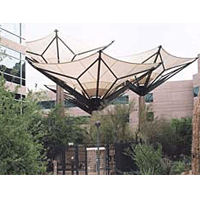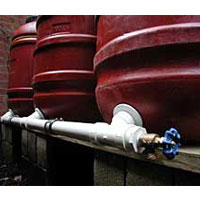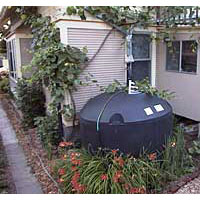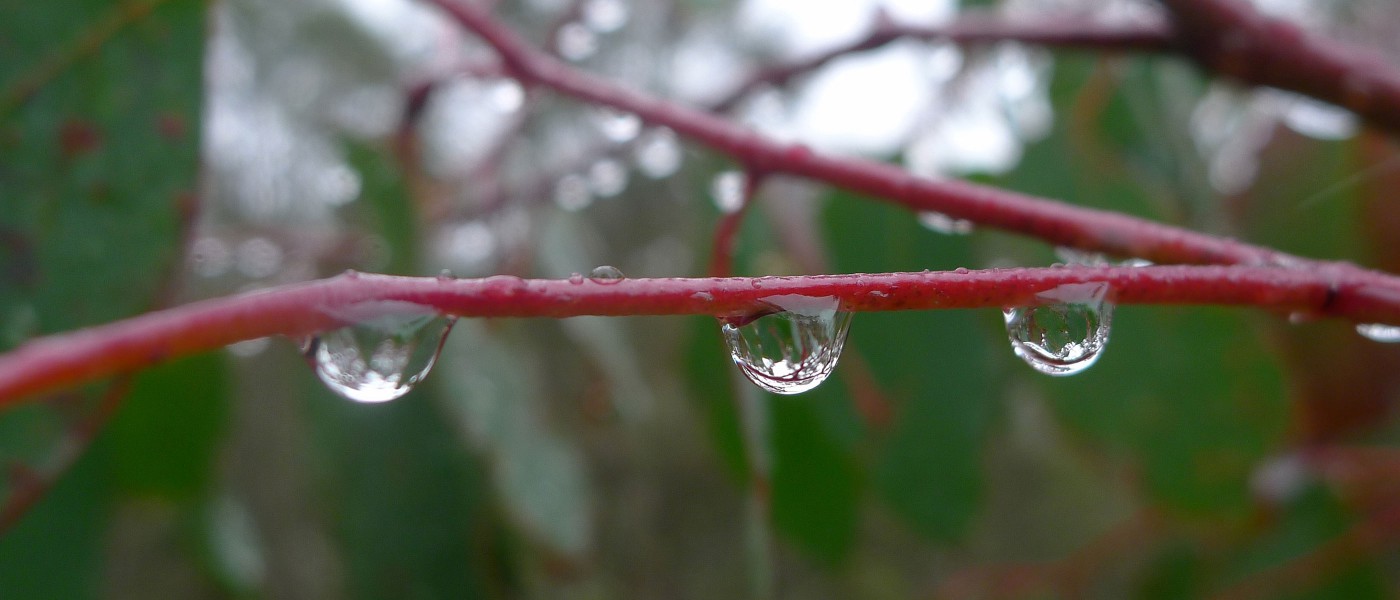Gardening with Rainwater
Although water may seem like a boundless resource, it is far from it. Only 2.5 percent of the planet's water is fresh, and 74 percent of that is tied up in the polar icecaps. Groundwater accounts for another 25 percent, leaving just 1 percent of freshwater to be found in lakes, rivers, soil, and air. Due to population growth, drought, and pollution, groundwater resources are seriously declining. Today the world fights over oil; tomorrow (if not already) it will fight over water.
Gardeners can play a key role in conserving freshwater by harvesting rainwater. In addition to reducing demand on our water supplies—especially important during drought and summer (when 40 percent of all water is used outdoors)—rainwater harvesting reduces water pollution. In a rainstorm, oil, pesticides, animal waste, and fertilizers from our lawns, sidewalks, driveways, and streets are washed into sewers that often overflow into rivers and estuaries, contaminating fish and other wildlife. Rainwater harvesting prevents rain from becoming polluted stormwater and puts it to use where it falls.
The quality of rainwater is unsurpassed when it comes to watering plants and landscapes. Captured rainwater is free of the salts and pollutants associated with ground and surface water. In urban areas, the natural acidity of rainwater is good for soils that have become alkaline from cement-leached lime. The natural temperature of rainwater doesn't shock plants with cold the way tap water can. Best of all, rainwater contains no chlorine, a chemical added to drinking water that inhibits plant growth. And rainwater is free!
Reviving an Ancient Practice
Rainwater harvesting began as early as 4,000 years ago in the Middle East, where runoff was collected in ditches for crop irrigation. Ancient Romans collected rainwater in underground cisterns and interior pools, where it slowly evaporated and cooled their homes. Up until a few generations ago, municipal water didn't really exist in America, and many folks relied on captured rainwater to meet their needs. Even today, large areas of the world, including the entire continent of Australia, still depend primarily on rainwater for their water supply.

Community gardeners have been among the first to revive rainwater harvesting in the U.S. In New York City, for example, since the drought of 2002, the Water Resources Group (WRG), a collaboration of community gardening and environmental organizations, has helped build demonstration rainwater harvesting systems in more than 20 community gardens. These systems together divert around 250,000 gallons of rainwater from NYC sewers each year.
Many cities have adopted creative, low-cost ways to stop wasting rainwater. Seattle Public Utilities has sponsored wildly successful sales of residential rain barrels, and Austin offers rebates of up to $500 for installation of rainwater harvesting systems. In Canada, Toronto offers a free service to homeowners to disconnect downspouts from the sewer system and install rain barrels, available at a discount.
Designing a Rainwater Harvesting System
Regardless of how much rain your area gets or how big your landscape is, you can design a rainwater harvesting system that works for you. The most common method of capturing rainwater for irrigation involves taking rain from building gutters and storing it in an outdoor tank or rain barrel.
Lenny Librizzi, assistant director at the Council on the Environment of NYC and a founding member of the Water Resources Group, says, "It isn't easy to come up with 'one size fits all' instructions for building rainwater harvesting systems because of variations in styles of roofs, downspouts, storage tanks, and garden layouts. You have to use a combination of research, common sense, ingenuity, and dumb luck to design and build your system."
Ideally, rainwater harvesting systems for irrigation include five basic components:
- Catchment or collection area—usually a roof;
- Transport for the water, such as gutters, downspouts, and piping;
- Roof washer to intercept the first flush of rain (plus any debris or bird feces) from the roof—usually a sealed downspout next to the main downspout;
- Storage tank or barrels;
- Gravity- or pump-driven system for distributing water to the garden.
Bear in mind that only nonpotable usage of rainwater is described here; harvesting rainwater for drinking involves several levels of filtration as well as chemicals for disinfection.
The first step in designing a rooftop system is to analyze (and, if you need to, change) the roof-surface materials. Roof material affects both the amount of water collected and its quality. For example: Porous asphalt shingles and rolled roofing are less desirable than smooth steel (although all are used successfully) because rough materials absorb more water and bird feces. Roofs made of wooden shingles treated with chromated copper arsenate are not appropriate for rainwater harvesting. Zinc antimoss strips mounted on roofs also produce toxic chemicals that you want to keep out of your garden.
Most people already have gutters and downspouts attached to their roofs to transport rainwater away from the building. Ideally, the gutters should be covered with a leaf screen to keep debris from entering the system. If you want to be able to divert water from your downspout during the growing season but shunt it back down the drain off-season, you can install a downspout diverter. These simple devices usually cost less than $20 at local hardware suppliers or on the Internet (for product information in this article, see "Rainwater Harvesting Resources").
Numerous roof washers and diverters are available, ranging in price from around $50 to over $600. For example, the Smart-Valve, from Flo True International, can be adjusted to flush away the first 10 to 60 gallons of rainwater and accommodates roofs up to 2,500 square feet. However, many small-system rainwater harvesters forgo separate roof washers and depend solely on the screens built into their barrel lids to filter out debris.

You can store rainwater in barrels, tanks, underground cisterns, or anything that protects it from contamination. Barrels made from dark materials block sunlight and discourage the growth of algae. A good rain barrel or tank has a tight-fitting cover to prevent evaporation and mosquito breeding. Water is heavy—a 500-gallon plastic tank filled with water can weigh more than two tons—so be sure your storage unit has a proper foundation and good support.
Rain barrels range in size from 40 to 80 gallons and, fitted with spigots and screened lids, sell from $60 to $200 a piece, but you can construct your own unit using recycled plastic barrels. These are widely available, especially from companies that ship food products. Instructions for outfitting your own rain barrels are available on the Internet and from the Water Resources Group. Rain barrels can be linked with hoses or pipes to gather water from one downspout, thus expanding storage capability. Be aware, however, that every hole and pipe fitting in your system represents an opportunity for leakage, probably the biggest problem you will face.
To figure out how much water you can collect from your roof, calculate your roof size and the average rainfall for your growing season. A good rule of thumb is that one inch of rainfall on a 1,000-square-foot roof produces 600 gallons of water. Maybe this is more than you bargained for in terms of storage, so be sure to install an overflow pipe near the lid of your system to carry away excess water.
To store a lot of water, you may want to invest in a polyethylene tank that can hold up to several thousand gallons. Be prepared to spend about one dollar per gallon of storage capacity. Polyethylene bladders are another alternative. Bladders can be ordered in many shapes and sizes for insertion into hard frames. Although bladders are relatively cheap compared with barrels and tanks, they don't last as long. Look for polyethylene bladders that are UV stabilized and 20 to 30 millimeters thick.
Directing the Flow
You'll also need to move water to the landscape. Most simple systems are gravity fed, meaning the rain barrel or storage tank is elevated above the area being watered. Many gardeners build small platforms from concrete blocks for their rain barrels and secure the barrels against building walls. More elaborate foundations with concrete footings are required to stabilize larger tanks. Consider connecting a passive drip irrigation system to your rainwater supply via the main spigot or the overflow pipe. Hand pumps can be used to draw stored rainwater up from underground tanks or to move it uphill across landscapes. Solar-powered pumps are another renewable-energy option. At the very least, plan to fit a watering can under a spigot at the bottom of your tank or barrel.

Don't forget to design where the overflow will go! Every rainwater system has its storage limits and should be fitted with an overflow outlet. Planting a rain garden to absorb the overflow is one of the most creative ways of using it. Or the overflow could be used to fill a dry streambed and send water to a thirsty grove of trees. You don't have to waste a single drop.
Although rainwater harvesting systems are low-tech, they do require minimal yearly maintenance. In the spring, clean any winter debris from your gutters and roof. Inspect and clean tank lids and barrel tops, paying special attention to their vents. Fill the system with a few inches of water to check connections for leaks. In the fall, before the weather freezes, remove drain plugs from the bottoms of barrels and open the main spigot to drain all barrels and tanks so that trapped water doesn't freeze, expand, and damage the system.
Rainwater Harvesting Resources
Further information
The NYC Water Resources Group offers a map of community gardens using rainwater harvesting systems, as well as how-to videos and a guide to designing your own system from recycled barrels. A book on rainwater harvesting, Forgotten Rain, by Phoenix-based landscape designer Heather Kinkade-Levario, can be purchased online at www.forgottenrain.com.
Rain Barrels and Cisterns
Rain barrels are widely available. One good source is Clean Air Gardening. A tool kit for outfitting your own recycled barrel can be purchased from the Garden Watersaver. Large, polyethylene tanks and cisterns are available from Snyder Industries. Tanks are also available from Arid Solutions Inc.
Diverters and Roof Washers
Flo True International sells the Smart-Valve roof-washing diverter. The Water Filtration Company manufactures a filtering roof washer. Downspout diverters can be purchased from the Gardener's Supply Company.


